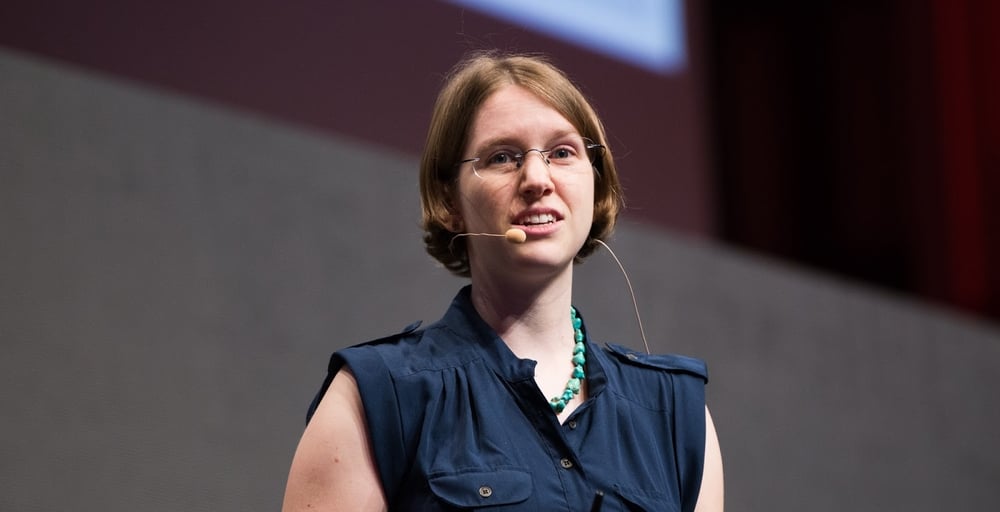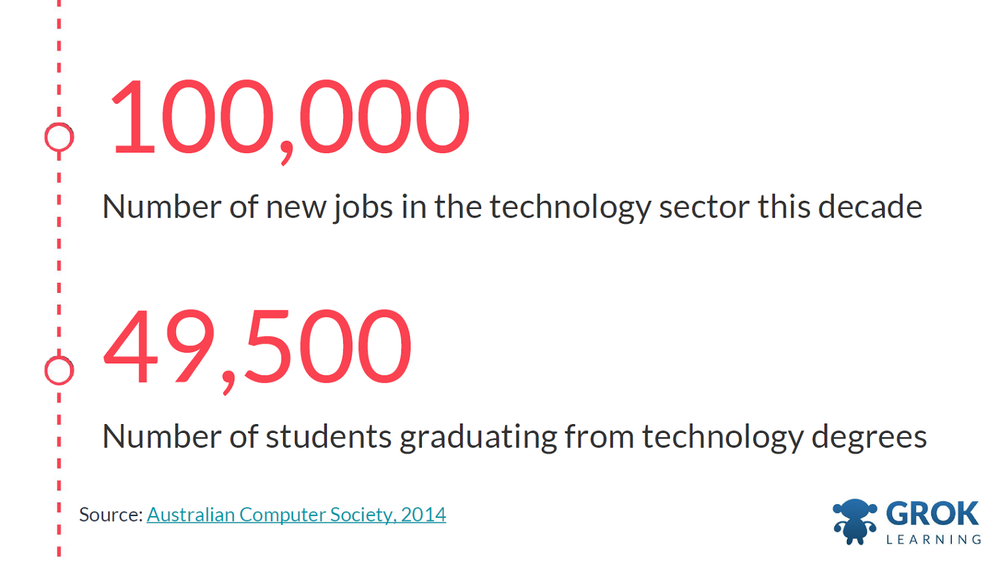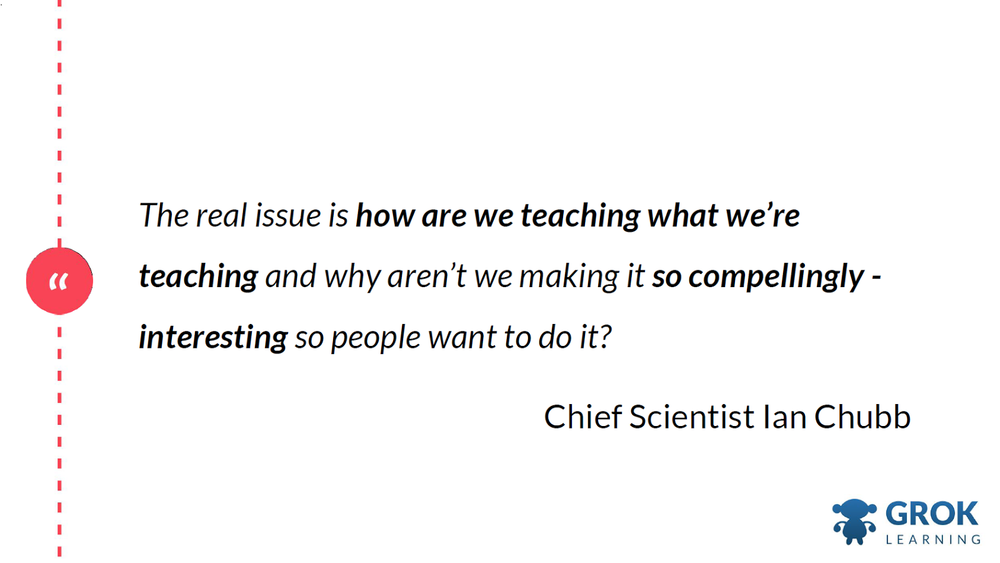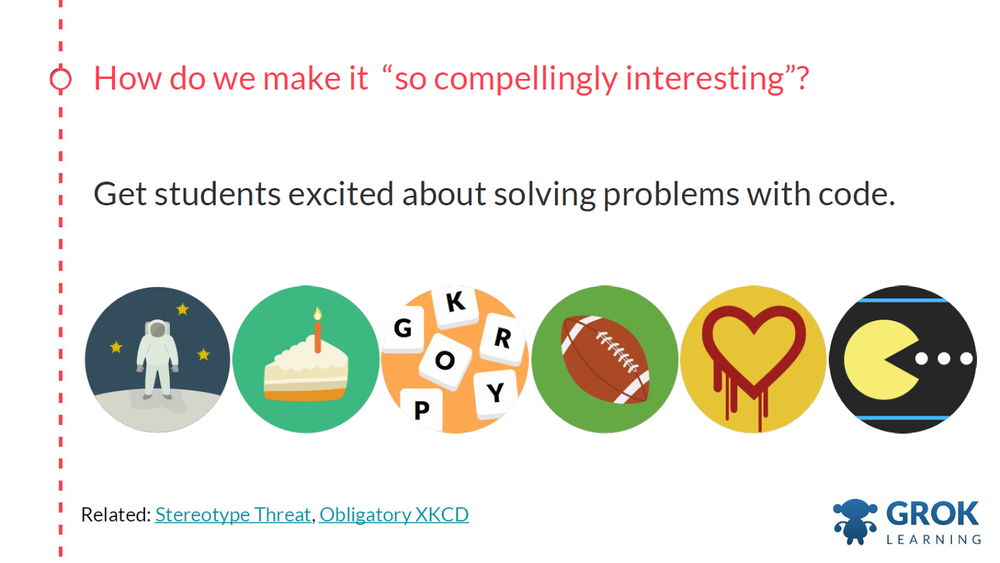“Australia is facing a massive skills shortage”
This revelation, is how Nicky Ringland began her talk.

The Lead Puzzlesmith and Co-founder at Grok Learning, as well as Outreach Officer for the National Computer Science School, Nicky is well-versed in the challenges of coding education. She cited a 2014 study by the Australian Computer Society, which found that 100,000 new jobs will be created in the technology industry within the next decade, but only 49,500 students will graduate from technology degrees at the same time. “Well may Australia of the future need to be agile, innovative, and creative, but if we can’t source and support the local talent, there is no way we can achieve this,” she declared.

Computer Science, specifically, shows very bad numbers at the moment. Fewer students are learning Computer Science at universities than they were 20 years ago. The statistics for schools are even worse. The number of students studying computing-related subjects, technology in the HSC – looking at just New South Wales alone – is plummeting.
A Game-changer on the Horizon
The good news is that a game-changer is on the horizon. According to Nicky, that is the new digital technologies curriculum as part of the National Curriculum that’s being rolled out across Australia. Beginning next year, every state – except for New South Wales who is dragging their heels – will be teaching computing as part of a core requirement for every student in Grade 5 and 6, and every student in Grade 7 and 8 will learn to code using a general purpose programming language like Python or Java. “This is amazing; it has an amazing potential for us in the technology sector, and for the students themselves. But so far, discussion of teacher development, professional development, and resources or the actual supporting of this curriculum have been conspicuously absent,” Nicky said.
How to Make Coding Compellingly Interesting

“The real issue is how are we teaching what we’re teaching and why aren’t we making it so compellingly-interesting so people want to do it?” – Chief Scientist Ian Chubb
Nicky told the SydStart audience that compellingly interesting, engaging experiences with code is exactly what she is about, and what her startup, Grok Learning, is about. “Because when you introduce Computer Science and STEM in an engaging way, in a way that students see the relevance, they absolutely get hooked,” she said.
The Making of Grok Learning
This comes from past experience, as Nicky has a non-computing background herself. She started with languages and linguistics, and only learned to code when she found a reason to do so. She found machine translation really bad and wanted to fix it, and so she took the plunge. She enrolled in a PhD in Computer Science and hasn’t looked back since.
Eventually, she became involved in outreach activities in trying to get kids engaged with code. She helps run the National Computer Science School from the University of Sydney, which brings kids from across Australia and New Zealand into an intensive 10-day summer camp. The problem was, the program doesn’t scale.
Thus, the NCSS Challenge – an online platform where students learned to code as they competed – came about several years ago. It prompted a lot of demand from schools, which enabled Nicky and her fellow co-founders to put up Grok Learning as a startup dedicated to teaching the world to code.
Startup Lessons
Nicky shared some key insights about founding Grok Learning:
- Grok Learning started from the ground up with scalability in mind.
- The site is practical. There’s a Python interpreter in the browser so teachers don’t have to navigate it, and students can engage with the content immediately.
- After introducing a concept, they have a question that tests the concept. Formative assessment is important in teaching students how to code without it being too frustrating.
- They’ve had nearly 2 million code submissions in two years, with over 120,000 students with accounts.
- They take teacher training and development seriously. Every teacher can learn to code on the site for free for their own professional development.
- They make it compellingly interesting by getting students excited about solving problems with code. They help students find their own passions and interests and see how these work with Computer Science.
- Grok Learning’s business model is the same as their impact model. They’ve deliberately aligned their social impact with their business.

Discovering a Sustainable Business Model
Nicky also imparted some lessons they learned in coming up with a sustainable business model.
- Reach a Reluctant Market – The only way to combat the issues of trying to educate a misinformed market is being incredibly stubborn and continuing to educate your audience until they understand the importance of what you’re trying to do. Also, not everything has to be scalable at first when you’re looking for your first customers.
- Motivate the Market – When you’ve identified your audience, you need to get them to actually commit to making a purchase.
- Form Partnerships – These help you stay motivated, and stay afloat, but don’t stray from your path.
Nicky ended her presentation by calling out to the startup community. “We need to scale to meet the challenge of the digital technology curriculum. I ask all of the startup community to continue to engage with their teachers, with their students, and with the local community in showing and demonstrating the importance of computing and Computer Science for Australia in general.”






